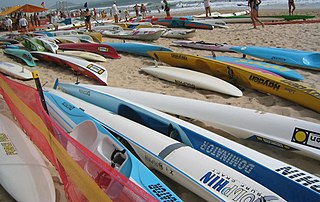
Surf lifesaving is a multifaceted social movement that comprises key aspects of voluntary lifeguard services and competitive surf sport. Originating in early 20th century Australia, the movement has expanded globally to other countries, including New Zealand, Ireland, South Africa, and the United Kingdom. Surf lifesavers in Australia are colloquially known as "Clubbies".
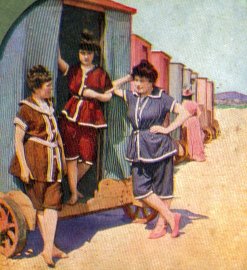
The bathing machine was a device, popular from the 18th century until the early 20th century, to allow people at beaches to change out of their usual clothes, change into swimwear, and wade in the ocean. Bathing machines were roofed and walled wooden carts that rolled into the sea. Some had solid wooden walls, others canvas walls over a wooden frame, and commonly walls at the sides and curtained doors at each end.
A seaside resort is a city, town, village, or hotel that serves as a vacation resort and is located on a coast. Sometimes the concept includes an aspect of official accreditation based on the satisfaction of certain requirements, such as in the German Seebad. Where a beach is the primary focus for tourists, it may be called a beach resort.

Felixstowe is a port town in Suffolk, England. The estimated population in 2017 was 24,521. The Port of Felixstowe is the largest container port in the United Kingdom. Felixstowe is approximately 72 miles (116 km) northeast of London.

Walton-on-the-Naze is a seaside town on the North Sea coast. It is part of the parish of Frinton and Walton, in the Tendring district in Essex, England. The town is located north of Clacton and south of the port of Harwich; Frinton-on-Sea lies to the south of the town. The town has a population of 12,054, according to the 2011 census; in 1931, the parish had a population of 3,071. The town attracts many visitors; The Naze and the pier are the main attractions.
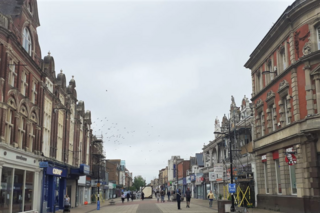
Boscombe is a suburb of Bournemouth, England. Historically in Hampshire, but today in Dorset, it is located to the east of Bournemouth town centre and west of Southbourne.
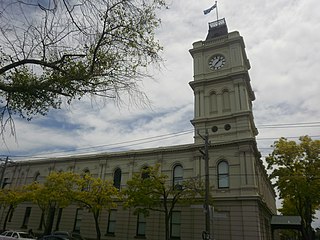
Brighton is a suburb in Melbourne, Victoria, Australia, 11 km south-east of Melbourne's Central Business District, located within the City of Bayside local government area. Brighton recorded a population of 23,252 at the 2021 census.

Torquay is a seaside resort in Victoria, Australia, which faces Bass Strait, 21 km south of Geelong and is the gateway to the Great Ocean Road. It is bordered on the west by Spring Creek and its coastal features include Point Danger and Zeally Bay. At the 2021 census, Torquay had a population of 18,534.

The Port of Felixstowe, in Felixstowe, Suffolk, is the United Kingdom's largest container port, dealing with 48% of Britain's containerised trade. In 2017, it was ranked as 43rd busiest container port in the world and 8th in Europe, with a handled traffic of 3.85 million twenty-foot equivalent units (TEU). In 2019 it was ranked the UKs 7th busiest port.

Bundoran is a town in County Donegal, Ireland. The town is located near the N15 road near Ballyshannon, and is the most southerly town in Donegal. The town is a tourist seaside resort, and tourism has been at the heart of the local economy since the 18th century. Bundoran is a surfing destination and was listed by National Geographic magazine in 2012 as one of the world's top 20 surf towns.
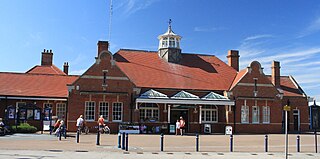
Felixstowe railway station is the eastern passenger terminus of the Felixstowe Branch Line, in the east of England and is the only surviving station serving the coastal town of Felixstowe, Suffolk. It is 15 miles 51 chains (25.2 km) down the line from Ipswich and 84 miles 30 chains (135.8 km) measured from London Liverpool Street; the preceding station on the line is Trimley. Its three-letter station code is FLX.

Sea bathing is swimming in the sea or in sea water and a sea bath is a protective enclosure for sea bathing. Unlike bathing in a swimming pool, which is generally done for pleasure or exercise purposes, sea bathing was once thought to have curative or therapeutic value. It arose from the medieval practice of visiting spas for the beneficial effects of the waters. The practice of sea bathing dates back to the 17th century but became popular in the late 18th century. The development of the first swimsuits dates from the period as does the development of the bathing machine.

Woolacombe is a seaside resort on the coast of North Devon, England, which lies at the mouth of a valley in the parish of Mortehoe. The beach is 2 miles (3.2 km) long, sandy, gently sloping and faces the Atlantic Ocean near the western limit of the Bristol Channel.

Cottesloe Beach is a popular beach in Cottesloe and one of the most iconic locations of Western Australia. The enduring popularity of the beach is the result of combination of factors including proximity to metropolitan Perth, accessibility by train, shelter from strong summer breezes and presence of offshore reefs making it a relatively safe swimming location. It has been recognised by the Heritage Council as a place of cultural significance since 2005. Since the beginning of the twentieth century a succession of bathing structures and hotels have been constructed in prominent locations overlooking the beach. The current beach-front structure was constructed in 1996 and is known as the Indiana Teahouse. Designed in a neotraditional architectural style it has become an internationally recognised landmark of Perth. The beach hosts the popular Rottnest Channel Swim, and Sculpture by the Sea. It attracts around 600,000 visitors per year.
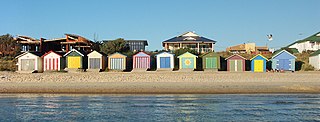
Boatsheds are generally lockable wooden sheds, often brightly colored, that were originally built to securely store small private boats and bathing materials directly on beaches. They are similar in appearance to beach huts, with the main difference being an integrated boat launching ramp directly to the beach. Many boatsheds also incorporate heavy-duty winches, which are used to winch a boat up from the water and back into the boatshed.
Mudeford is a harbourside and beachside parish based on a former fishing village in the east of Christchurch, Dorset, England, fronting water on two sides: Christchurch Harbour and the sands of Avon Beach.

The Brighton Fishing Museum is a registered independent museum established in co-operation with the local fishing community in 1994. This museum is dedicated to Brighton's fishing and seaside history. It is located a short distance to the west of Brighton Pier within an area known as the Fishing Quarter, occupying two of the arches on the Kings' Road, which runs along Brighton's beachfront. Admission is free and donations appreciated.

North Beach Precinct is a heritage-listed precinct at Cliff Road, North Wollongong, City of Wollongong, New South Wales, Australia. It includes North Wollongong Beach, the North Beach/Wollongong Bathing Pavilion, Puckey's Salt Works, the Tram Cutting, Battery Park and Smiths Hill. It was added to the New South Wales State Heritage Register on 17 June 2005.

The Brighton Bathing Boxes are 93 beach huts on Dendy Street Beach in Brighton, Victoria, Australia, in the City of Bayside. They are a significant tourist attraction for the area. They are valued at at least A$300,000 per bathing box.





















